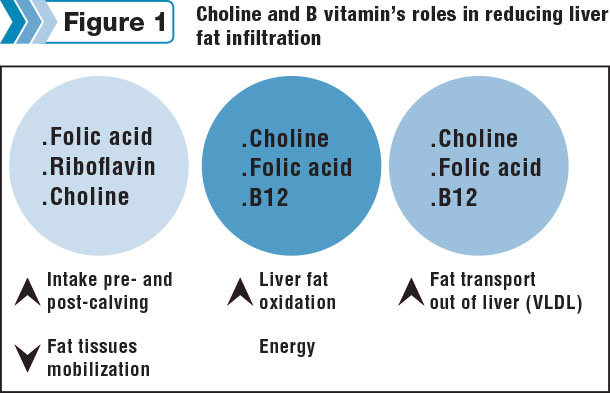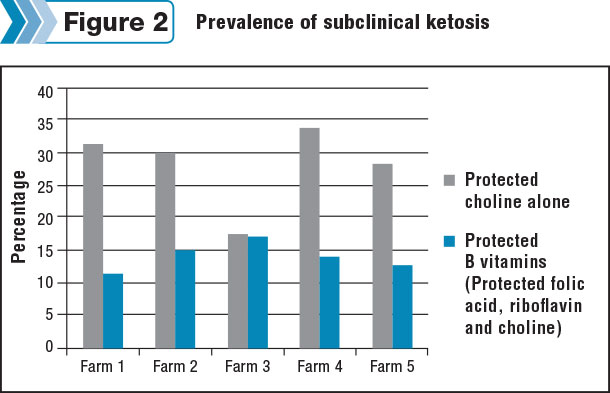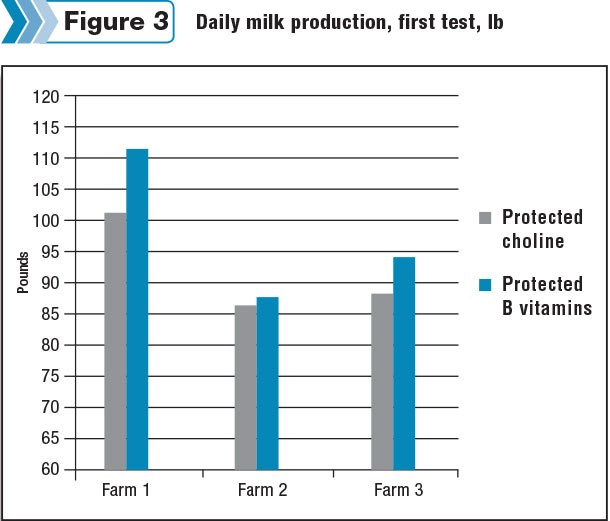The transition period is a very challenging period for the dairy cow. Her metabolism needs to adapt rapidly from a non-lactating to a lactating stage, and the reproductive system is preparing new ova for the next breeding period.
This sudden change increases the dairy cow’s energy requirement by three times with a very high demand for glucose for milk synthesis and from potential need for reproductive performance. Adipose tissues become resistant to insulin to spare glucose.
Often dry matter intake is not sufficient to meet this increased energy requirement, and fat tissues are mobilized to produce non-esterified fatty acids as an additional energy source. This adaptive metabolism is normal with our high-producing cows, but it becomes detrimental when the extent of fat tissue mobilization is more important than the liver’s capacity to metabolize it.
The liver will be infiltrated with fat and will have reduced functionalities.
Liver health is crucial for the dairy cow since it is involved in many important functions like glucose production, detoxification of ammonia, production of antibodies, etc.
Ruminants are different from monogastrics (swine, poultry) because rumen microbes metabolize (modify) the glucose supplied by the diet into volatile fatty acids. The dairy cow needs to synthesize glucose, and the liver is where the synthesis occurs. In early lactation, a dairy cow producing 88 pounds of milk will need 6.4 pounds of glucose per day just for milk production.
This places added pressure on the liver. Obviously, liver health becomes crucial to maximize glucose production.
A supply of crucial nutrients is a good tool to improve liver health during the transition period. Choline and some B vitamins, like folic acid, B12 and riboflavin, play specific roles to either reduce tissue fat mobilization, improve liver fat oxidation and increase fat export out of the liver (Figure 1). These valuable functions will alleviate liver fat infiltration.

A blend of choline, folic acid and riboflavin was shown to increase dry matter intake prepartum; this results in additional energy and is a critical parameter to reduce the need for fat tissue mobilization.
Choline and folic acid are involved in the production of carnitine necessary for liver fat oxidation, which helps to reduce the amount of fat that may have infiltrated the liver and reduce its functionality. B12 also plays a role in liver fat oxidation, through a different mechanism, by reducing the level of methyl malonic acid.
Choline, folic acid and B12 are methyl donors, meaning they will exchange a methyl group with other compounds; this is mandatory for the production of very low-density lipoprotein (VLDL), which is used to transport fat out of the liver.
There is a very high demand for methyl donors during the transition period. The amino acid methionine is also a good source of methyl groups, but its role in reducing liver fat infiltration is not clear since other functions like milk protein synthesis and immunity take priority.
Choline is involved in production of milkfat, and the demand for choline during early lactation is prioritized for milk production at the expense of production of VLDL for liver fat export. Folic acid and B12 are linked in their function as methyl donors and their use for reduction of liver fat infiltration increased during the transition period.
A well-recognized and practical indicator of liver health is the measurement of beta-hydroxy butyrate (BHB) during the transition period. BHB will be produced in higher quantity mainly when liver fat oxidation is incomplete due to elevated liver fat infiltration. High blood BHB is also related to ketosis incidence.
Studies done on large commercial farms compared the dietary supplementation of a blend of protected folic acid, riboflavin and choline to protected choline alone. It showed a benefit of the three vitamins blend on the reduction of blood BHB levels during the transition period (Figure 2).

The percentage of cows with blood BHB levels greater than or equal to 1.2 mmol per liter indicates the herd prevalence of subclinical ketosis. Dairy cows were healthier and produced more milk (Figure 3).

The improvement over choline alone may be explained by the important role of folic acid and riboflavin on liver health.
Protected B vitamins are an innovative tool to improve the liver health of your cows during their transition period. Healthier liver means healthier cows and will lead to increased milk production and improved reproduction. This represents substantial economic gains for your farm. PD
References omitted but are available upon request. Click here to email an editor.

-
Hélène Leclerc
- Technical Support and R&D – Ruminant Nutrition
- Jefo
- Email Hélène Leclerc







